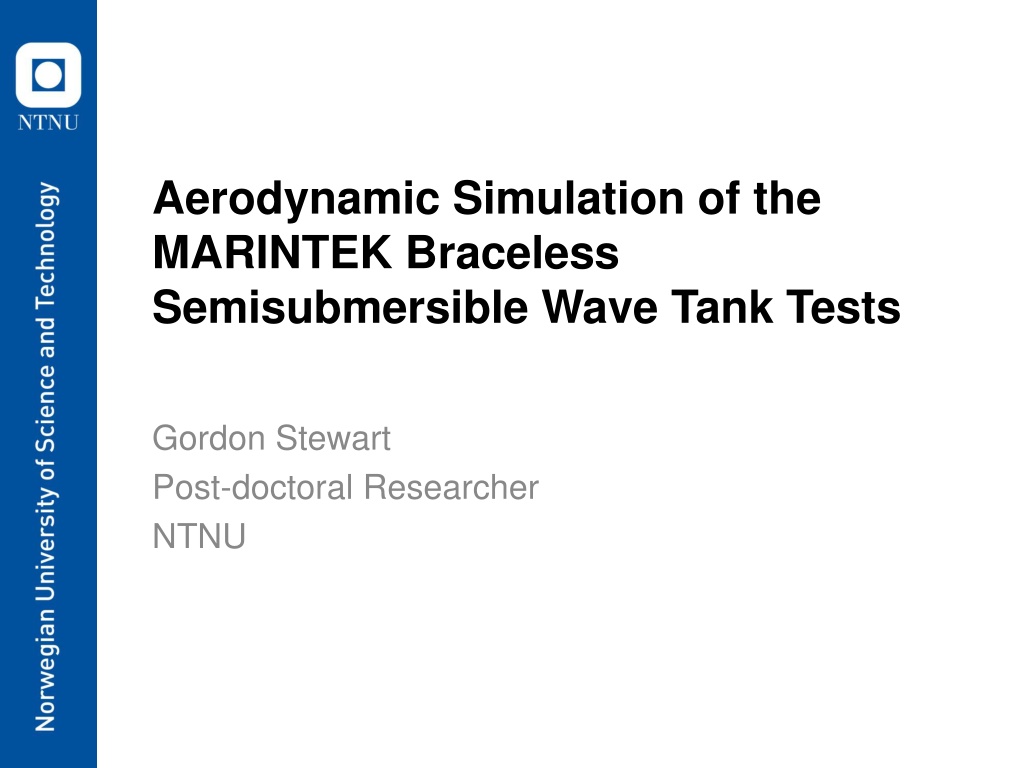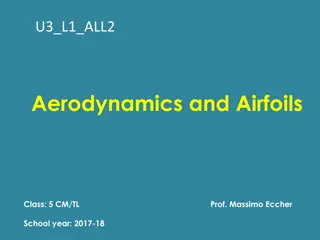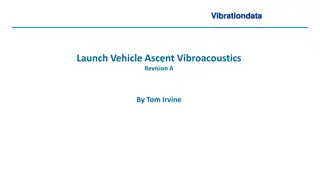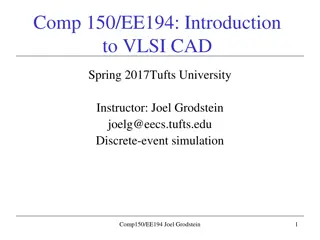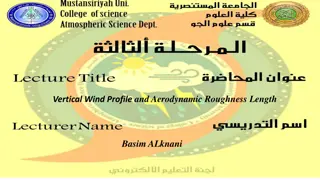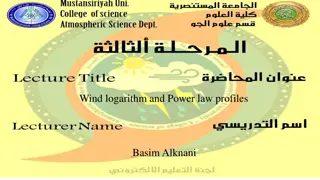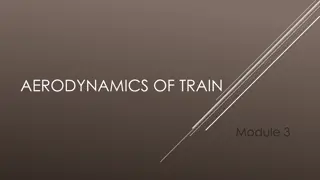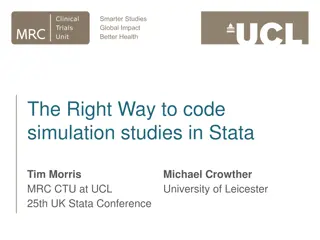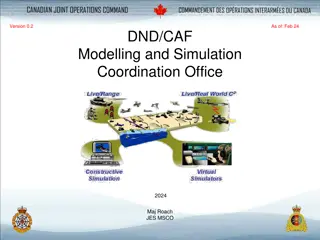Aerodynamic Simulation of MARINTEK Braceless Semisubmersible: Insights and Tools
Explore the aerodynamic simulation of the MARINTEK Braceless Semisubmersible through advanced techniques and tools. Discover the unique aerodynamic actuator, simulation models, and tools used in the research conducted by Gordon Stewart, a post-doctoral researcher at NTNU. Gain insights into the experimental setup, simulation methodologies, and the application of FAST software for analyzing rotor forces in simulated conditions.
Download Presentation

Please find below an Image/Link to download the presentation.
The content on the website is provided AS IS for your information and personal use only. It may not be sold, licensed, or shared on other websites without obtaining consent from the author. Download presentation by click this link. If you encounter any issues during the download, it is possible that the publisher has removed the file from their server.
E N D
Presentation Transcript
Aerodynamic Simulation of the MARINTEK Braceless Semisubmersible Wave Tank Tests Gordon Stewart Post-doctoral Researcher NTNU
MARINTEK Braceless Semisubmersible 1/30thFroude scale braceless semisubmersible Uses a scaled version of the NREL 5MW turbine Features a novel aerodynamic actuator that consists of 6 wires that are tensioned by motors to provide aerodynamic forces, which eliminates the issue of the Reynolds/Froude scaling mismatch that occurs for scaled experiments This actuator is controlled by a blade- element momentum theory based code that allows for real-time coupling between platform motion and the simulated aerodynamic forces Figure courtesy of MARINTEK 2
Aerodynamic Modeling Forces applied to Platform Turbsim Wind file Platform Motion Aerodyn How to best model the aerodynamic actuator used in these experiments? 3
Aerodynamic Modeling Forces applied to Platform Turbsim Wind file Platform Motion Aerodyn Contained within simulation tool How to best model the aerodynamic actuator used in these experiments? 4
Aerodynamic Modeling Forces applied to Platform Turbsim Wind file Platform Motion Aerodyn Bypass aero- solver, use experimental forces directly How to best model the aerodynamic actuator used in these experiments? 5
Simulation Tool The MARINTEK data was unavailable at the time of this research, so results from a simulation only study will be presented Uses a modified version of FAST, from NREL, that allows for the bypassing of the aerodynamics solver by reading an external file of rotor forces 6
Description of Simulations Conducted A set of FAST simulations at various wind speeds and wave heights were run using the OC3 spar buoy floating platform An artificial experiment was created by running a set of baseline simulations The rotor forces of the baseline simulation were recorded and used in place of the aerodynamic forces in a second set of simulations. For these simulations, the coefficient of drag of the platform is modified to represent modeling inaccuracies 7
Coefficient of Drag Modification- Tower Bending Moment Standard Deviation On the left, both sets of simulations use the baseline version of FAST with AeroDyn enabled, but using 2 different Cd values; 0.6 (the original value), and 0.5 On the right, the baseline values with the original Cd of 0.6 is compared to a set of simulations that used the aerodynamic loads from the baseline, but has a lower Cd value 8
Phase of Loading is Important This figure on the left shows a comparison between a baseline simulation with 4 m initial surge and a simulation that uses the aerodynamic forces from the baseline simulation, but starts with an initial surge of zero meters The figure on the right shows a comparison of three simulations: baseline with initial platform pitch 5 degrees (blue solid line), initial pitch of -5 degrees using the aerodynamic forces from the baseline (green dashed line), no aerodynamic forces and initial pitch of -5 degrees (red dot-dashed line) 9
Conclusions Using aerodynamic forces directly from the experiment is relatively accurate as long as the hydrodynamic modeling is also accurate However, if there are larger inaccuracies in hydrodynamic modeling, especially inaccuracies in phase or frequency in platform degrees of freedom, other methods of aerodynamic modeling may be necessary Hybrid actuation systems like the one used in the MARINTEK experiments create many opportunities for the creation of accurate and useful experimental data, but the modeling of the aerodynamic system must be approached with care 10
Acknowledgements The research leading to these results has received funding from the European Union s Seventh Framework Program (FP7/2007-2013) under grant agreement number 609795 Thanks to my colleagues at MARINTEK for their help with this work, especially Erin Bachynski, Madjid Karimirad, and Thomas Sauder Also thanks to my supervisor, Michael Muskulus 11
Supplemental: Coefficient of Drag Modification- Surge Standard Deviation On the left, both sets of simulations use the baseline version of FAST with AeroDyn enabled, but using 2 different Cd values; 0.6 (the original value), and 0.5 On the right, the baseline values with the original Cd of 0.6 is compared to a set of simulations that used the aerodynamic loads from the baseline, but has a lower Cd value 12
Supplemental: Different Wave Field- Surge Standard Deviation In these plots, instead of modifying the Cd, a new irregular wave field is created for each simulation with the same Hs and Tp as the baseline, which represents the inability of some design codes from using a wave height time series as an input 13
Supplemental: Different Wave Fields- Surge These plots are selected time series from a 10 m/s mean wind speed simulation, showing the surge for the two wave seeds. Note the similar trends in surge even with different wave inputs, due to the wind being the same and surge being dependent mostly on the thrust force 14
Supplemental: Different Wave Field- Tower Bending Moment Standard Deviation Here again, a new irregular wave field is created for each simulation with the same Hs and Tp as the baseline, which represents the inability of some design codes from using a wave height time series as an input 15
Supplemental: Different Wave Fields- Tower Bending 4 3x 10 Baseline (Seed 1) Predefined Aero Loads (Seed 2) 2.5 Fore-aft Tower Bending Moment (kNm) 2 1.5 1 0.5 0 -0.5 -1 100 120 140 160 180 200 Time (s) Here, for the tower bending moment time series, the result is more wave-dominated The comparison of the baseline with wave random seed 2 and the same wave seed with predefined aerodynamic loads (lower right) shows very similar loads due to these simulations having the same waves 16
